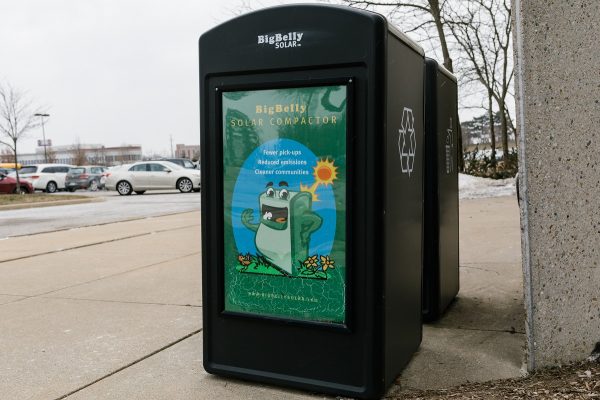
A solar compactor on campus. Sara Faraj | Washtenaw Voice
Danny Villalobos
Staff Writer
Washtenaw Community College’s push for a zero carbon emission campus is saving more than just energy—sustainability efforts have helped the college lower its energy, gas and water costs by thousands.
WCC now spends about $1.92 million in energy, natural gas, and water each year, compared to the $2.4 million that the college spent in 2008, according to Bill Ghrist, the manager of energy and system integration here on at the college.
“On average, the school has saved around $250,000 since 2008,” Ghrist said.
Bill Ghrist is a member of the WCC Sustainability Council and advises the council on practical energy use. As part of his role in facilities management, he keeps energy, gas and water consumption as low as possible.
As a part of WCC’s 2014 Climate Action and Sustainability Plan, the college intends decrease carbon emissions by 2 percent each year. Since 2008, the college’s net emissions fell by more than 15 percent, according to a report from Second Nature, which collects data on the college’s progress towards zero carbon emissions.
The drop in spending is attributed to many factors, according to Ghrist, including new equipment recently installed on campus.
Recently, about 650 units of LED lights were installed in the automotive area of the Occupational Education building, saving the college around $6,000 per year, while also improving lighting, Ghrist said.
New boilers were installed in the Business Education building, replacing ones dating back to 1996. The new boilers deliver better temperature output and reduce gas consumption by 35-45 percent, Ghrist said.
Other efforts include replacing old light bulbs with new bulbs and replacing all external campus lights with LEDs.
One factor to note are weather conditions during the year. On warm days, the college’s daily energy consumption is relatively low. The opposite is true for days with low temperatures.
“During the winter vortex there was a large amount of energy used: natural gas and electricity skyrocketed due to the air vents being used to get the warm air moving,” said Ghrist.
In 2014, the college’s net emissions increased from 2008. Reasons include a “winter vortex” that year, which lasted about 10 days. This year’s vortex lasted about 3 days.
The current Climate Action and Sustainability Plan is scheduled to be updated, and proposals will be presented to the board of trustees in May, said Dale Petty, a college faculty member on the Sustainability Council, in a previous interview.

